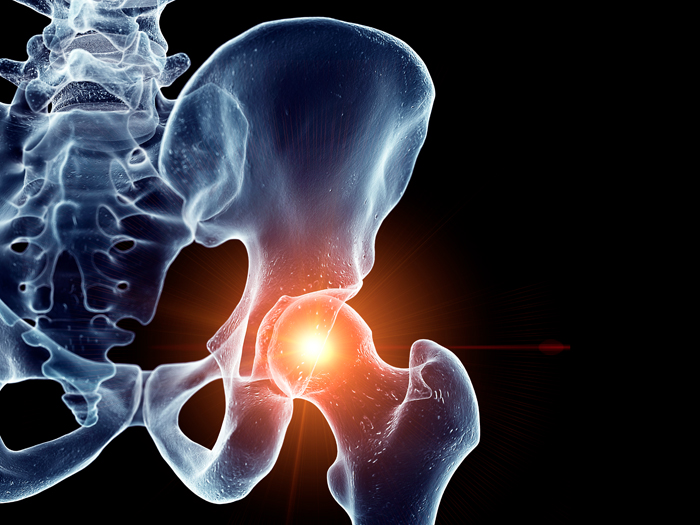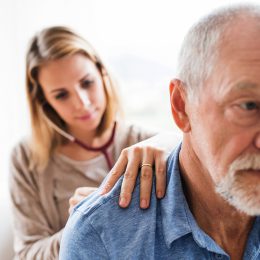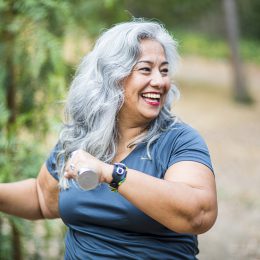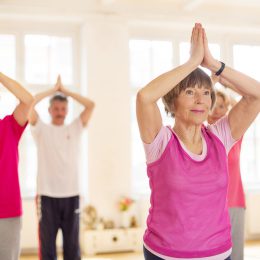8 Steps You Should Take After a Hip Fracture
Get back on your feet faster—and help yourself avoid a repeat injury—with this essential guide.

If you don’t know someone who’s fallen and broken a hip, you will. According to the latest statistics, 300,000 older adults are hospitalized each year with a hip fracture.
Not only is this type of injury incredibly painful, but it also puts many older adults on the road to permanent disability and loss of independence. Even worse, about 30 percent of elderly people who fracture a hip will die within a year.
The first month after a fracture is an especially crucial time. What you do—or don’t do—during those few weeks can make all the difference.
“People don’t die of hip fractures,” says Karl Koenig, M.D., medical director of the Musculoskeletal Institute at UT Health Austin. “They die of downstream problems like pneumonia, [infected] bed sores, and blood clots.”
Dr. Koenig adds that most of the people whose health takes a turn for the worse after a fracture had a serious underlying health issue, such as Parkinson’s disease or Alzheimer’s disease, that led to their fall. If you’re otherwise healthy and broke your hip by tripping over a rug, your odds of bouncing back are far greater.
While preventive measures—like knowing what to do in case of a fall—help tremendously, if you or a loved one suffers a fall and breaks a hip, it’s time to kick a slightly different plan into action. Following these steps will boost your odds of recovering well so you can get back to your usual activities faster and minimize your risk of a future fracture.
Step #1: Get Moving ASAP
Surgery is usually a must after a hip fracture, and it will help with the pain right away. Some breaks can be addressed with a surgical repair, while others call for a hip replacement. Either way, your goal should be to get up and walking within 24 hours of your procedure, Dr. Koenig says.
That might mean simply taking a few steps with the help of a walker, nurse, or physical therapist so you can get used to getting on and off the bed and making your way to the bathroom.
The sooner you start moving around, the better. “Many people can start walking later the same day” following surgery, Dr. Koenig says.
Step #2: Take Physical Therapy Seriously
Starting physical therapy quickly after surgery will increase your chances of reclaiming your mobility. That might entail spending some time in a rehab facility or heading home and then participating in an outpatient physical therapy program. Most people who are recovering from a hip fracture need physical therapy for at least four to eight weeks.
Meanwhile, Dr. Koenig urges patients to take advantage of recommendations from their physical therapists, even if that means getting past any embarrassment you might feel about using a walker or cane. Remember: Not only are you aiming to build up your strength, but you’re also trying to avoid fracturing the other hip!
Step #3: Get Smart About Pain Meds
You’ll probably need pain relievers for a few weeks or months after your fracture. While using some opioid, or narcotic, medication is okay for most seniors, Dr. Koenig cautions against relying too heavily on it. His concern for older adults isn’t primarily about addiction—but side effects like constipation, nausea, vomiting, confusion, and drowsiness.
Talk to your doctor about following a “multimodal approach,” which might include different types of treatment:
- Taking a lower dose of opioids for a short period of time
- Using over-the-counter meds like ibuprofen or acetaminophen
- Testing out non-drug complementary therapies like acupuncture
Learn more about the pros and cons of opioid use after surgery in our guide to opioid safety.
Step #4: Treat Osteoporosis
If you’ve had a hip fracture, you have osteoporosis, Dr. Koenig says. Bone health often gets overlooked during the recovery process, but focusing on it is important if you want to avoid future breaks, he says.
His advice: Anyone over age 50 should talk with their doctor about their calcium and vitamin D intake. Your doctor may recommend supplements or a prescription for an osteoporosis drug, so discuss the pros and cons with your doctor to learn what’s best for you.
Step #5: Identify and Address Any Underlying Health Issues
Most older adults who fall and fracture a hip have a health problem that played a role in the injury. Is your blood pressure medication making you dizzy, or your anxiety medication affecting your thinking or balance? Are you overdue for an eye exam—and maybe a new prescription?
Talk to your health care providers, and try to figure out what led to your fall so you can treat that problem directly. The more information your doctors have, the easier it will be to pinpoint any issues. Let your doctors know about any:
- Chronic conditions you have
- Recent illnesses or injuries
- Medications you take, including prescriptions, OTC drugs, and supplements
Step #6: Rethink Your Fitness Routine
Low-impact, weight-bearing activities—or standing activities that require your body to support its own weight—are essential because they help strengthen your bones. Short, easy walks are an easy, effective place to start. As you get stronger, brisk walking, dancing, and climbing stairs are other terrific activities.
Dr. Koenig says he often refers patients to SilverSneakers classes because they’re a great way to get active while having fun with your peers, plus they incorporate light resistance exercise that strengthens muscles. Check your SilverSneakers eligibility instantly here.
Meanwhile, try to work some core-strengthening and balance activities into your weekly routine. Core exercises aim to build strength in your abdomen, back, and hips so it’s easier to hold yourself upright. Practicing tai chi or performing any of these balance exercises can improve your stability.
Be sure to check with your doctor or physical therapist before engaging in new or more strenuous activities. Asking these six questions after a fall-related injury can help you feel safe—and confident—during exercise.
Subscribe to our newsletter
It's quick and easy. You could be one of the 13 million people who are eligible.
Already a member? Click to discover our 15,000+ participating locations.
Follow Us
Step #7: Fall-Proof Your Home
Falls are the leading cause of hip fractures, and many falls occur at home. In fact, a small study in the Journals of Gerontology found falls happen most often in bedrooms. Other areas of concern, according to health experts: bathrooms and stairs.
Now’s a good time to check around your home make sure it’s safe. Clear any clutter you might trip over, make sure the lighting is bright enough for everyone to see clearly, and add railings or grab bars to showers, toilets, and staircases.
For more simple tips, check out our step-by-step guide to preventing falls at home.
Step #8: Stop After One Drink
When you were younger, you might have been able to down a cocktail—or several—and remain relatively stable.
Now that you’re older, unfortunately, your balance simply isn’t as good as it used to be. Add alcohol to the mix, and you have a recipe for toppling over.
Dr. Koenig’s advice: Scale way back on the booze. The National Institute on Alcohol Abuse and Alcoholism agrees, suggesting that people ages 65 and older cap their intake at one drink per day.
As you get older, your blood alcohol level may rise more quickly than it did when you were younger, thanks to a change in body composition, including a decrease in muscle mass. In other words, one drink might start to feel like two or three.
Aside from affecting your balance, alcohol can also interfere with medications or cause negative interactions. Play it safe by following any medication instructions or asking your doctor if you have questions.
Take Your Favorite SilverSneakers Classes Online!
SilverSneakers members can access live fitness classes and wellness workshops through SilverSneakers LIVE. See the latest schedule and RSVP for classes here.
Not a member? If you have a Medicare Plan, it may include SilverSneakers—at no additional cost. Check your eligibility instantly here.




